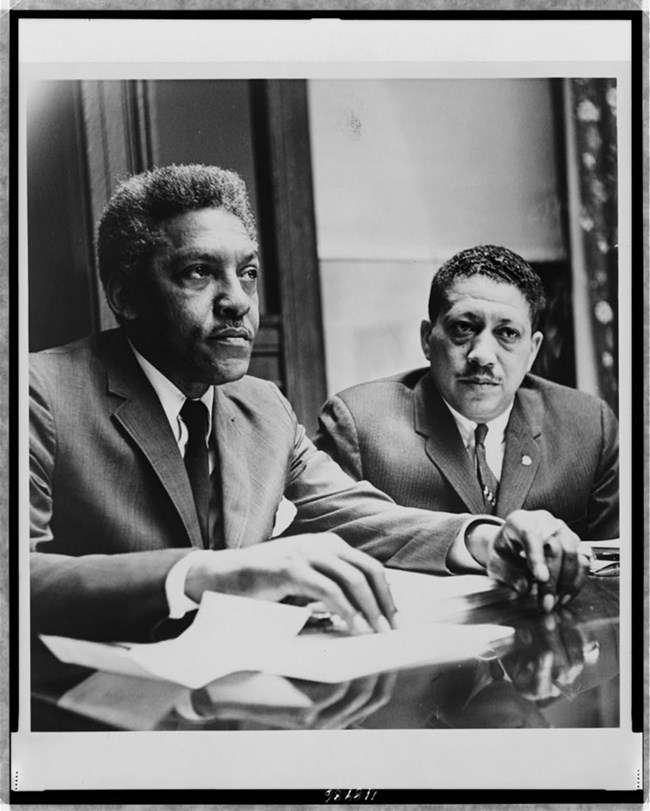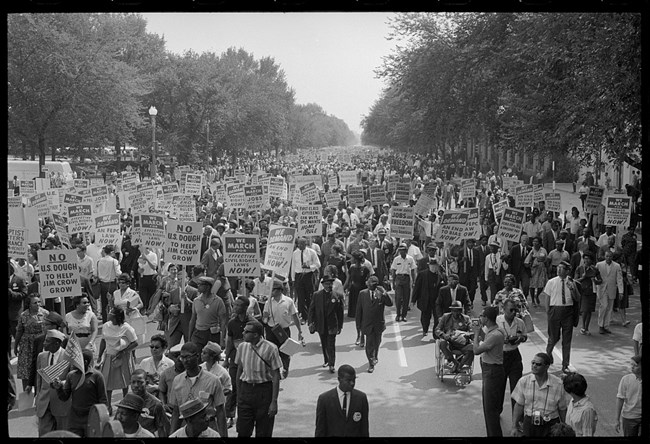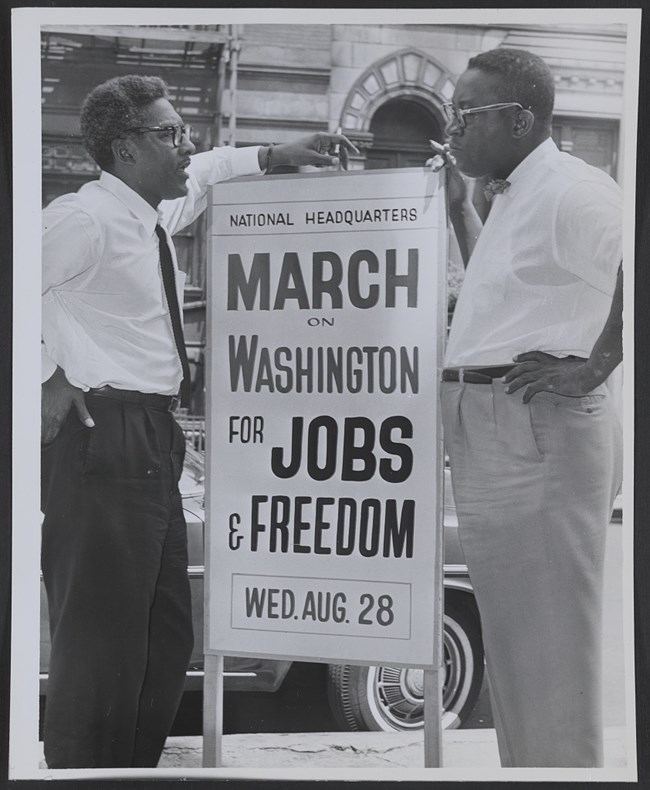Part of a series of articles titled Curiosity Kit: Bayard Rustin.
Article
Learning from Bayard Rustin

This Curiosity Kit Educational Resource was created by Katie McCarthy a NCPE intern with the Cultural Resources Office of Interpretation and Education.
Background:
Born in 1912, Bayard Rustin became an important American civil rights leader. Rustin worked on civil rights campaigns beginning in the 1940s. One of Rustin’s biggest triumphs was as a primary organizer for the 1963 March on Washington for Jobs and Freedom. In addition to his civil rights work for racial equality, Rustin was gay. Despite his abilities as an organizer and leader, Rustin was often kept out of the public eye by other civil rights leaders due to his sexual orientation. During the 1970s and 1980s, Rustin worked on humanitarian missions and advocated for gay rights. In November 2013, President Barack Obama posthumously awarded Rustin the Presidential Medal of Freedom. You can learn more about Rustin’s life and career by exploring this article about Rustin, and The Places of Bayard Rustin.
Objectives:
-
Explore the role of individuals in civil rights activism.
-
Learn about Rustin’s role in the March For Washington and other civil rights protests.
-
Examine primary sources for central ideas and historical evidence.
-
Integrate visual information with print and digital sources.
Inquiry Question:
What kind of power does one individual have to create change? How do you, or can you, work to create change in your community?

Activity One:
When historians research an event from the past, they use primary sources. Primary sources are documents and objects that were created by people who experienced the event themselves, and are normally written at the time of the event. They include such things as diary entries, letters, newspaper articles, speeches, art, and photographs. Many photographers documented the 1963 March on Washington for Jobs and Freedom, which Bayard Rustin helped to organize. Take a minute to explore these photographs.
Image 1 Link: https://www.loc.gov/item/2013648845/
Image 1 Caption: Aerial view, looking north from the Washington Monument, of the March on Washington, 1963. Photo by Marion S. Trikosko, Library of Congress.
Image 2 Link: https://www.si.edu/object/marchers-martin-luther-king-jrs-1963-march-washington:siris_sic_13017
Image 2 Caption: Marchers participating in the March on Washington. Photo by James Wallace, Smithsonian Institution Archives, Record Unit 371, Box 4, Folder: August 1983.
Image 3 Caption: Aerial view of the March on Washington, from the Lincoln Memorial to the Washington Monument. Photo by Warren K. Leffler, LOC, LC-U9- 10360-5
Image 4 Link: https://www.loc.gov/item/2013647401/
Image 4 Caption: Protesters at 1963 March on Washington. Photo by Marion S. Trikosko, Library of Congress.
As you explore the images, consider the following questions:
-
What do you think is happening in these photos? What makes you think that?
-
What do you notice about the people in the photos? Do you notice any patterns regarding apparent age, sex, or race?
-
What does the body language in the photos tell you about how the people in the images are feeling?
-
What catches your eye? What details do you notice?
-
How do you think the people in the images were feeling? How do you think the photographer was feeling when they took the photo?
-
How do the images make you feel?
-
What stories do the images tell?
-
What would you like to learn more about after exploring these images?

Activity Two:
Bayard Rustin, along with other civil rights activists, made their opinions heard in many ways, including planning marches, participating in boycotts, and sharing their message with state and local government officials. People who care about making lives better today continue to use these methods. Now it’s your turn! This activity has three steps. First, decide on what message you want to share. What local or national cause are you passionate about? Second, figure out who should receive this message. You should do research to find out your:
-
Senators and Congressional Representatives for your district
-
Mayor
-
Governor
-
Your town’s council members (or equivalent)
-
Members of your state’s legislature representing you
After researching these officials, decide who would be best able to respond to your message. Are you concerned about a local issue? Then your town’s mayor or councilmembers might be the best recipients. Are you advocating for a change on the state level? Then you might want to contact your governor or members of your state’s legislature. If you’re focused on a national cause, contacting your congressional representative or senators might be the most effective!
Once you’ve chosen your cause and decided who to share it with, the final step is to create your message. Write a letter, explaining your cause and why it is important, and what outcome you would like to see. Remember to support your position with examples, and to be polite, informative, and accurate. Once you’ve written your letter, send it to your chosen recipient digitally or by mail.
Activity Three:
When people want to commemorate a person or event, they often build monuments or memorials. There are many memorials in Washington D.C., and some of them, like the Lincoln Memorial played an important role in civil rights protests. Some, like the Martin Luther King, Jr. Memorial honor civil rights leaders themselves.
After exploring Bayard Rustin’s life using the Places of Bayard Rustin, take time to design a monument honoring his life and achievements. As you sketch your monument, consider the following questions:
-
What message or messages do you want your monument to convey?
-
What should it look like? Will it be big or small? What shape should it be? What kind of texture will it have?
-
Will it have words or symbols on it? If it will, how will you choose those words or symbols?
-
Where should the memorial be located? If you chose one of the locations from the Places of Bayard Rustin, why is that location more important than the others?
-
Are you commemorating one part of Rustin’s life more than others? If so, why?
-
How does this monument compare to other monuments you’ve seen before?
-
Are there monuments in your community? Who or what do they celebrate? What are the words or symbols that convey their meaning?
Tags
Last updated: February 19, 2025
